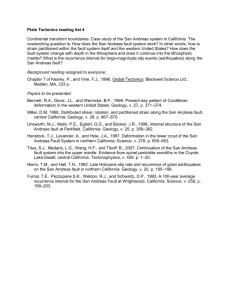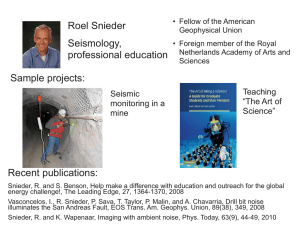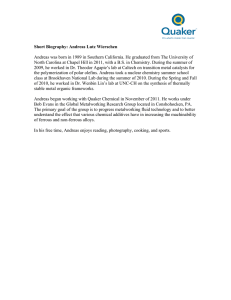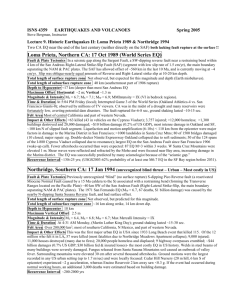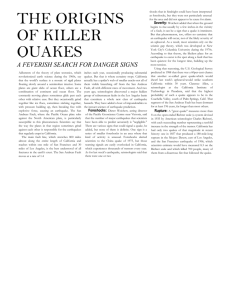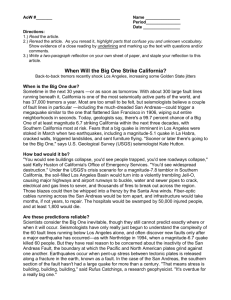VOLUME 89 NUMBER 38 16 SEPTEMBER 2008 PAGES 349–360
advertisement
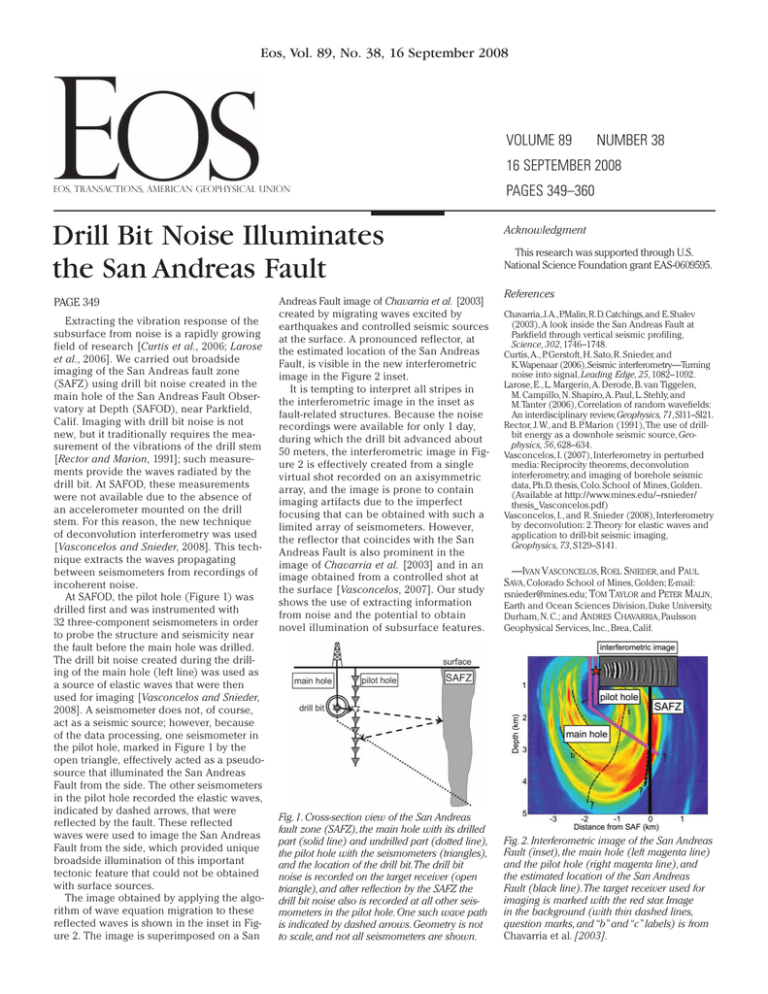
Eos, Vol. 89, No. 38, 16 September 2008 VOLUME 89 NUMBER 38 16 SEPTEMBER 2008 EOS, TRANSACTIONS, AMERICAN GEOPHYSICAL UNION PAGES 349–360 Drill Bit Noise Illuminates the San Andreas Fault Acknowledgment PAGE 349 Extracting the vibration response of the subsurface from noise is a rapidly growing field of research [Curtis et al., 2006; Larose et al., 2006]. We carried out broadside imaging of the San Andreas fault zone (SAFZ) using drill bit noise created in the main hole of the San Andreas Fault Observatory at Depth (SAFOD), near Parkfield, Calif. Imaging with drill bit noise is not new, but it traditionally requires the measurement of the vibrations of the drill stem [Rector and Marion, 1991]; such measurements provide the waves radiated by the drill bit. At SAFOD, these measurements were not available due to the absence of an accelerometer mounted on the drill stem. For this reason, the new technique of deconvolution interferometry was used [Vasconcelos and Snieder, 2008]. This technique extracts the waves propagating between seismometers from recordings of incoherent noise. At SAFOD, the pilot hole (Figure 1) was drilled first and was instrumented with 32 three- component seismometers in order to probe the structure and seismicity near the fault before the main hole was drilled. The drill bit noise created during the drilling of the main hole (left line) was used as a source of elastic waves that were then used for imaging [Vasconcelos and Snieder, 2008]. A seismometer does not, of course, act as a seismic source; however, because of the data processing, one seismometer in the pilot hole, marked in Figure 1 by the open triangle, effectively acted as a pseudosource that illuminated the San Andreas Fault from the side. The other seismometers in the pilot hole recorded the elastic waves, indicated by dashed arrows, that were reflected by the fault. These reflected waves were used to image the San Andreas Fault from the side, which provided unique broadside illumination of this important tectonic feature that could not be obtained with surface sources. The image obtained by applying the algorithm of wave equation migration to these reflected waves is shown in the inset in Figure 2. The image is superimposed on a San Andreas Fault image of Chavarria et al. [2003] created by migrating waves excited by earthquakes and controlled seismic sources at the surface. A pronounced reflector, at the estimated location of the San Andreas Fault, is visible in the new interferometric image in the Figure 2 inset. It is tempting to interpret all stripes in the interferometric image in the inset as fault-related structures. Because the noise recordings were available for only 1 day, during which the drill bit advanced about 50 meters, the interferometric image in Figure 2 is effectively created from a single virtual shot recorded on an axisymmetric array, and the image is prone to contain imaging artifacts due to the imperfect focusing that can be obtained with such a limited array of seismometers. However, the reflector that coincides with the San Andreas Fault is also prominent in the image of Chavarria et al. [2003] and in an image obtained from a controlled shot at the surface [Vasconcelos, 2007]. Our study shows the use of extracting information from noise and the potential to obtain novel illumination of subsurface features. Fig. 1. Cross-section view of the San Andreas fault zone (SAFZ), the main hole with its drilled part (solid line) and undrilled part (dotted line), the pilot hole with the seismometers (triangles), and the location of the drill bit.The drill bit noise is recorded on the target receiver (open triangle), and after reflection by the SAFZ the drill bit noise also is recorded at all other seismometers in the pilot hole. One such wave path is indicated by dashed arrows. Geometry is not to scale, and not all seismometers are shown. This research was supported through U.S. National Science Foundation grant EAS-0609595. References Chavarria, J. A., P.Malin, R. D. Catchings, and E. Shalev (2003), A look inside the San Andreas Fault at Parkfield through vertical seismic profiling, Science, 302, 1746–1748. Curtis, A., P. Gerstoft, H. Sato, R. Snieder, and K.Wapenaar (2006), Seismic interferometry—Turning noise into signal, Leading Edge, 25, 1082–1092. Larose, E., L. Margerin, A. Derode, B. van Tiggelen, M. Campillo, N. Shapiro, A. Paul, L. Stehly, and M. Tanter (2006), Correlation of random wavefields: An interdisciplinary review, Geophysics, 71, SI11–SI21. Rector, J. W., and B. P. Marion (1991), The use of drillbit energy as a downhole seismic source, Geophysics, 56, 628–634. Vasconcelos, I. (2007), Interferometry in perturbed media: Reciprocity theorems, deconvolution interferometry, and imaging of borehole seismic data, Ph.D. thesis, Colo. School of Mines, Golden. (Available at http://www.mines.edu/~rsnieder/ thesis_Vasconcelos.pdf) Vasconcelos, I., and R. Snieder (2008), Interferometry by deconvolution: 2. Theory for elastic waves and application to drill-bit seismic imaging, Geophysics, 73, S129–S141. —IVAN VASCONCELOS, ROEL SNIEDER, and PAUL SAVA, Colorado School of Mines, Golden; E-mail: rsnieder@mines.edu; TOM TAYLOR and PETER MALIN, Earth and Ocean Sciences Division, Duke University, Durham, N. C.; and ANDRES CHAVARRIA, Paulsson Geophysical Services, Inc., Brea, Calif. Fig. 2. Interferometric image of the San Andreas Fault (inset), the main hole (left magenta line) and the pilot hole (right magenta line), and the estimated location of the San Andreas Fault (black line).The target receiver used for imaging is marked with the red star. Image in the background (with thin dashed lines, question marks, and “b” and “c” labels) is from Chavarria et al. [2003].
